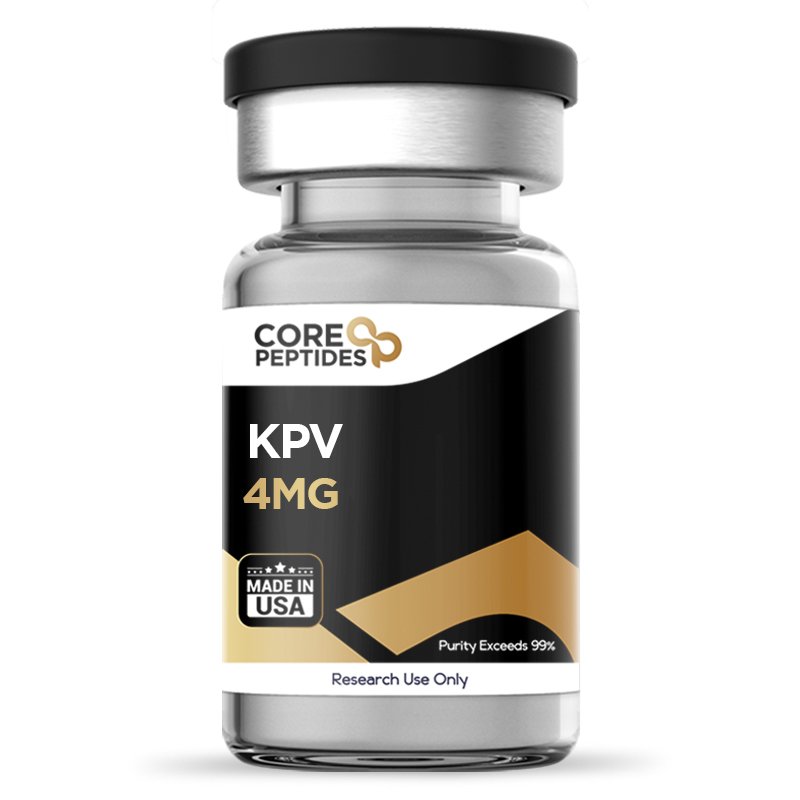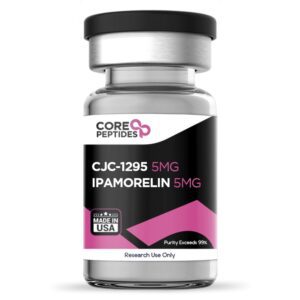Description
KPV Peptide (Lys-Pro-Val)
KPV peptide is a small tripeptide fragment derived from the C-terminal end of the alpha-melanocyte-stimulating hormone (α-MSH), an endogenous peptide hormone comprising 13 amino acids. α-MSH belongs to the melanocortin family of peptides and is well-known for its roles in regulating skin pigmentation, metabolic processes, and immune responses. The KPV sequence—composed of lysine (K), proline (P), and valine (V)—represents the core functional motif responsible for many of α-MSH’s biological effects, particularly its anti-inflammatory and tissue-protective properties.
KPV is classified as a bioactive peptide fragment, meaning that even in isolation from the full α-MSH molecule, it retains a remarkable capacity to influence cellular signaling pathways, modulate immune responses, and promote tissue repair. Its small molecular size enables efficient tissue penetration and cellular uptake, making it a promising candidate for therapeutic and experimental research applications.
Chemical Makeup
-
Sequence: Lys-Pro-Val
-
Molecular Formula: C16H30N4O4
-
Molecular Weight: 342.43 g/mol
-
Other Names: MSH (11-13), ACTH (11-13), alpha-MSH (11-13 fragment)
The KPV peptide is structurally simple but functionally potent, with its C-terminal position in α-MSH being critical for receptor interaction and downstream signaling.
Mechanisms of Action
1. Anti-Inflammatory Activity
KPV exhibits notable anti-inflammatory effects by modulating immune cell activity and cytokine production. Research suggests that it can inhibit the release of pro-inflammatory cytokines such as tumor necrosis factor-alpha (TNF-α) and interleukin-6 (IL-6) in various cell types. Its mechanisms are thought to include:
-
Receptor-mediated signaling: While α-MSH acts primarily through melanocortin-1 receptors (MC1R), KPV may exert effects both dependent and independent of MC1R, suggesting flexibility in its pathways.
-
Inhibition of vasopermeability: Studies on murine models demonstrated that KPV reduces swelling in inflamed tissues, such as ears in dermatitis models, likely by suppressing excessive vascular permeability.
These properties make KPV a promising molecule for research into autoimmune and inflammatory disorders, including inflammatory bowel disease and skin inflammation.
2. Intestinal Protection and Gastrointestinal Health
A major area of research for KPV involves its protective effects on intestinal tissues:
-
In murine models of chemically induced bowel inflammation, KPV administration was observed to reduce inflammatory cell infiltration, decrease tissue edema, and accelerate recovery.
-
KPV may also improve intestinal epithelial barrier function, supporting mucosal healing in inflamed colonic tissue.
-
The peptide has been shown to interact with PepT1 transporters, facilitating targeted delivery to sites of inflammation within the gastrointestinal tract.
-
It also significantly reduces myeloperoxidase (MPO) activity, indicating diminished neutrophil-mediated tissue damage.
Collectively, these findings suggest KPV’s potential as a therapeutic candidate for conditions like ulcerative colitis and other inflammatory bowel diseases.
3. Wound Healing and Tissue Repair
KPV has demonstrated promising effects in tissue repair and wound healing:
-
Corneal epithelial healing: In vitro and in vivo studies show that KPV accelerates epithelial re-epithelialization following corneal injury, possibly via nitric oxide (NO)-mediated pathways. Exposure to nitric oxide inhibitors attenuates this effect, highlighting the peptide’s reliance on NO signaling for tissue repair.
-
Cutaneous wound healing: Animal studies indicate that KPV accelerates healing by reducing inflammatory cell infiltration, stimulating fibroblast activity, and promoting extracellular matrix formation.
-
Scar reduction: In controlled studies, KPV-treated wounds displayed smaller scar areas and better tissue remodeling compared to untreated controls. These benefits are largely attributed to its anti-inflammatory and regenerative properties.
4. Other Biological Effects
Beyond inflammation and tissue repair, KPV shows additional potential biological actions:
-
Antipyretic effects: Early studies demonstrated that KPV can reduce fever in animal models, suggesting a modulatory role in central thermoregulation.
-
Cell viability and proliferation: KPV has been shown to support the viability and proliferation of epithelial cells, further indicating its reparative and protective capacity in tissues subjected to injury or stress.
Clinical and Research Applications
KPV peptide is primarily used in research and laboratory settings. Its demonstrated activities make it a molecule of interest for studying:
-
Inflammatory bowel diseases and gastrointestinal inflammation
-
Cutaneous and ocular wound healing
-
Anti-inflammatory therapies targeting cytokine-mediated conditions
-
Experimental studies on melanocortin-related signaling pathways
Due to its small size, high tissue penetrance, and potent bioactivity, KPV serves as an important experimental tool for investigating the therapeutic potential of α-MSH derivatives without the complexity of the full-length hormone.
Summary
KPV peptide is a C-terminal tripeptide fragment of α-MSH with broad biological potential, particularly in anti-inflammatory activity, intestinal protection, wound healing, and scar reduction. By modulating immune responses, supporting tissue regeneration, and interacting with critical cellular pathways (such as MC1R and NO signaling), KPV has emerged as a significant molecule in both basic and translational research. Its small size and simplicity make it an excellent candidate for future development in therapeutic peptides targeting inflammatory and regenerative pathways.
References:
-
Dalmasso, G., Charrier-Hisamuddin, L., Nguyen, H. T., Yan, Y., Sitaraman, S., & Merlin, D. (2008). PepT1-mediated tripeptide KPV uptake reduces intestinal inflammation. Gastroenterology, 134(1), 166–178. https://doi.org/10.1053/j.gastro.2007.10.026
-
Hiltz, M. E., & Lipton, J. M. (1989). Antiinflammatory activity of a COOH-terminal fragment of the neuropeptide alpha-MSH. FASEB J., 3(11), 2282–2284. https://pubmed.ncbi.nlm.nih.gov/2550304/
-
Brzoska, T., Luger, T. A., Maaser, C., Abels, C., & Böhm, M. (2008). Alpha-melanocyte-stimulating hormone and related tripeptides: Biochemistry, antiinflammatory and protective effects. Endocrine Reviews, 29(5), 581–602. https://doi.org/10.1210/er.2007-0027
-
Klaus Kannengiesser et al. (2008). Melanocortin-derived tripeptide KPV has anti-inflammatory potential in murine models of inflammatory bowel disease. Inflammatory Bowel Diseases, 14(3), 324–331. https://doi.org/10.1002/ibd.20334





Reviews
There are no reviews yet.